 |
| Articles on artifacts, painting, and calligraphy |
|
|
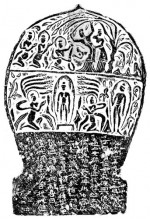 The Institute has approximately 40,000 rubbings of more than 28,000 bronze and stone items. Except for a few donations, most of these were purchased in the early 1920s. Among the Institute’s collection, many rubbings are not recorded in other sources; some of them were made at an early date or are of exceptional quality. Four themes are exhibited: “Full-surface Rubbings of Bronze Artifacts”chosen because of the fine technique of the rubbing, or because the typology of the original bronzes is not recorded in catalogues, or because of earlier scholars' writings on.....
The Institute has approximately 40,000 rubbings of more than 28,000 bronze and stone items. Except for a few donations, most of these were purchased in the early 1920s. Among the Institute’s collection, many rubbings are not recorded in other sources; some of them were made at an early date or are of exceptional quality. Four themes are exhibited: “Full-surface Rubbings of Bronze Artifacts”chosen because of the fine technique of the rubbing, or because the typology of the original bronzes is not recorded in catalogues, or because of earlier scholars' writings on.....
|
|
Read more...
|
|
|
Eastern Chou (771 – 221 BC) |
|
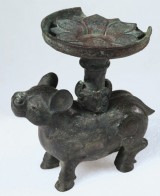 The objects in this collection are excavated around the 1930s, from tomb M60 in the Liu-li-ko cemetery, Hui-hsien, Honan and tomb M1 in Shan-piao-chen, Chi-hsien. Both tombs belong to the Eastern Chou period.
The objects in this collection are excavated around the 1930s, from tomb M60 in the Liu-li-ko cemetery, Hui-hsien, Honan and tomb M1 in Shan-piao-chen, Chi-hsien. Both tombs belong to the Eastern Chou period.
Tomb M60 in the Liu-li-ko cemetery measures 5.8 m east-west by 4.7 north-south. Located at the center of cemetery, it certainly is a tomb of the ruling class with abundant accompanying burial artifacts. This tomb is dated to the Middle Spring and Autumn period (mid seventh—mid sixth century B.C.) or slightly earlier.Tomb M1 in Shan-piao-chen is the largest tomb in.....
|
|
Read more...
|
|
Western Chou (mid 11th century—771 B.C.) |
|
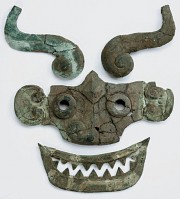 This area demonstrates tomb M60 and horse-and-chariot pit M3 excavated at Hsin-ts’un, Chun-hsien, Honan. M60 is among the few tombs undisturbed by looters at this Western Chou cemetery. Inside the tomb, the burial space measures 2.85m in its length and 1.6m in its width, with only a single coffin. Though not many accompanying burial artifacts are presented, the sources of these artifacts are rather complicated. Among these artifacts, there are relatively larger numbers of weapons and.....
This area demonstrates tomb M60 and horse-and-chariot pit M3 excavated at Hsin-ts’un, Chun-hsien, Honan. M60 is among the few tombs undisturbed by looters at this Western Chou cemetery. Inside the tomb, the burial space measures 2.85m in its length and 1.6m in its width, with only a single coffin. Though not many accompanying burial artifacts are presented, the sources of these artifacts are rather complicated. Among these artifacts, there are relatively larger numbers of weapons and.....
|
|
Read more...
|
|
|
The Ruins of Yin (Late 14th century – Mid 11th century BC) |
|
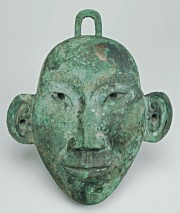 From 1928 to 1937, the Institute conducted fifteen seasons of excavation of the Yin-hsu site. Eleven large tombs, along with more than 1300 small graves, had been discovered on the highlands of Hsi-pei-kang, located on the northern shore of the Huan River. Whereas in the Hsiao-t’un village on the southern shore of the river, three well structured hang-t’u (pounded earth) construction sites were found.
From 1928 to 1937, the Institute conducted fifteen seasons of excavation of the Yin-hsu site. Eleven large tombs, along with more than 1300 small graves, had been discovered on the highlands of Hsi-pei-kang, located on the northern shore of the Huan River. Whereas in the Hsiao-t’un village on the southern shore of the river, three well structured hang-t’u (pounded earth) construction sites were found.
The Museum separates topics of the Yin-hsu area into the “Shang Royal Cemetery at Hsi-pei-kang” and the “Shang Palace and Ancestral Temples at.....
|
|
Read more...
|
|
Lung-shan culture (2600 – 2000 BC) |
|
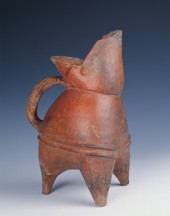 In 1928, Wu Chin-ting, one of the research fellows of the Institute, first discovered the remains of the Lung-shan culture in Cheng-tze-yai, at the town Lung-shan, Shantung. Later in 1934, lead by Li Chi, other researchers of the Institute found more remains of the Lung-shan culture along the eastern coastline of Shantung Province. The next year, test excavations were carried out at the Wa-wu-ts'un and Ta-ku-tui sites in Liang-ch'eng-chen. These excavations established the foundation for the study of.....
In 1928, Wu Chin-ting, one of the research fellows of the Institute, first discovered the remains of the Lung-shan culture in Cheng-tze-yai, at the town Lung-shan, Shantung. Later in 1934, lead by Li Chi, other researchers of the Institute found more remains of the Lung-shan culture along the eastern coastline of Shantung Province. The next year, test excavations were carried out at the Wa-wu-ts'un and Ta-ku-tui sites in Liang-ch'eng-chen. These excavations established the foundation for the study of.....
|
|
Read more...
|
|
|
|
|
<< Start < Prev 1 2 3 4 5 6 7 8 9 10 Next > End >>
|
|
Page 9 of 16 |